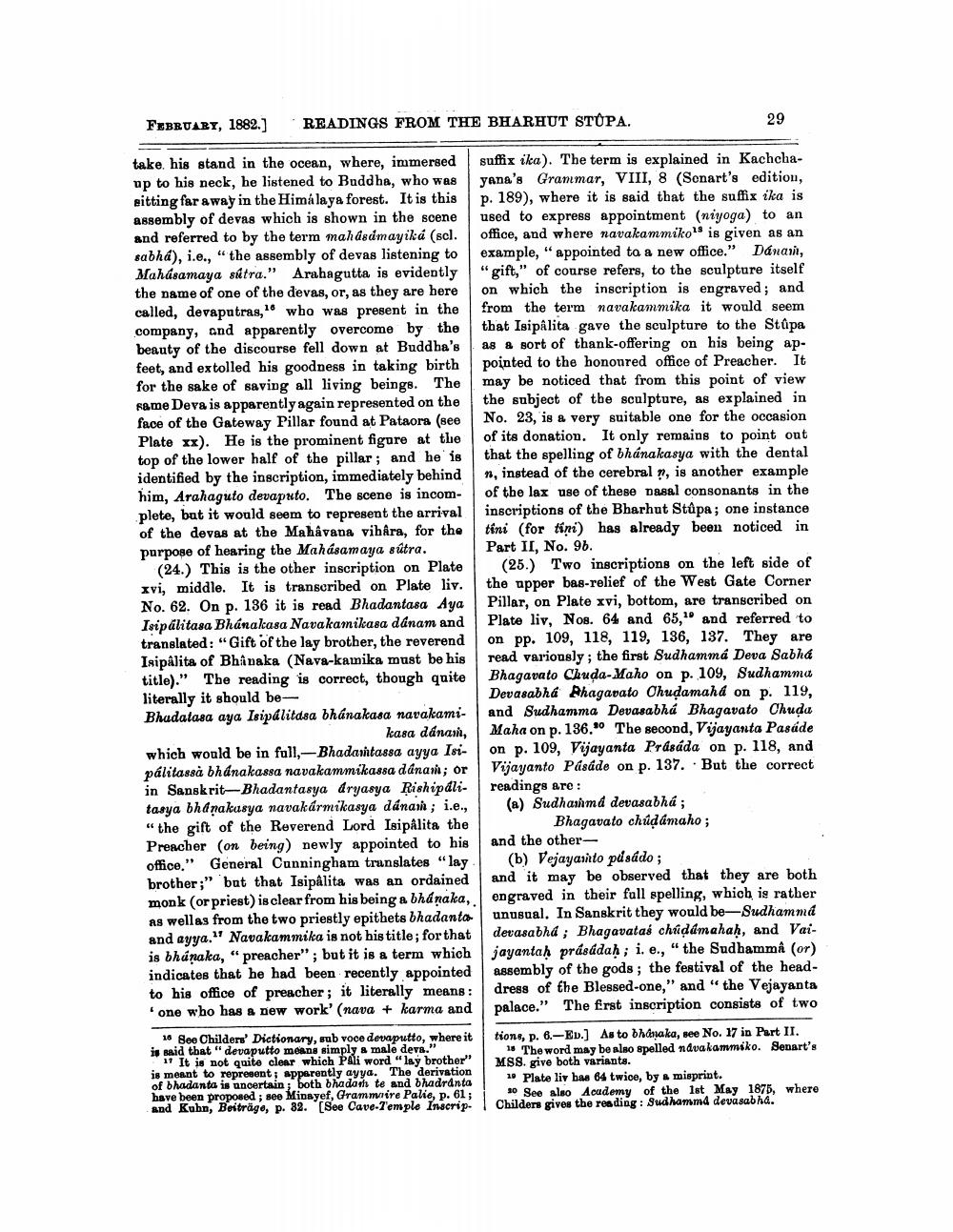________________
FEBRUARY, 1882.)"READINGS FROM THE BHARHUT STUPA.
29
take his stand in the ocean, where, immersed suffix ika). The term is explained in Kachchaup to his neck, he listened to Buddha, who was yana's Granımar, VIII, 8 (Sonart's edition, eitting far away in the Himalaya forest. It is this p. 189), where it is said that the suffix ika is assembly of devas which is shown in the scene used to express appointment (niyoga) to an and referred to by the term mal dedmayiká (scl. office, and where navakammiko's is given as an sabhd), i.e., "the assembly of devas listening to example, "appointed to a new office." Dánari, Mahasamaya satra." Arahagutta is evidently "gift," of course refers, to the sculpture itself the name of one of the devas, or, as they are here on which the inscription is engraved ; and called, devaputras, who was present in the from the term navakanmika it would seem company, and apparently overcome by the that Isipâlita gave the sculpture to the Stapa beauty of the discourse fell down at Buddha's as & sort of thank-offering on his being apfeet, and extolled his goodness in taking birth pointed to the honoured office of Preacher. It for the sake of saving all living beings. The may be noticed that from this point of view Rame Deva is apparently again represented on the the subject of the sculpture, as explained in face of the Gateway Pillar found at Pataora (see No. 23, is a very suitable one for the occasion Plate xx). He is the prominent figure at the of its donation. It only remains to point out top of the lower half of the pillar; and he is that the spelling of bhánakasya with the dental identified by the inscription, immediately behind | *, instead of the cerebral, is another example him, Arahaguto devaputo. The scene is incom- of the lax use of these pasal consonants in the plete, but it would seem to represent the arrival inscriptions of the Bharhut StûPA; one instance of the devas at the Mahavana vihara, for the tini (for tini) has already been noticed in purpose of hearing the Mahasamaya sútra. Part II, No. 9b.
(24.) This is the other inscription on Plate (25.) Two inscriptions on the left side of xvi, middle. It is transcribed on Plate liv. the upper bas-relief of the West Gate Corner No. 62. On p. 136 it is read Bhadantasa Aya Pillar, on Plate xvi, bottom, are transcribed on Isipalitasa Bhánakasa Navakamikasa dánam and Plate liv, No. 64 and 65, and referred to translated: "Gift of the lay brother, the reverend on pp. 109, 118, 119, 136, 137. They are Isipalita of Bhanaka (Nava-kamika must be his read variously; the first Sudhammá Deva Sabha title)." The reading is correct, though quite Bhagavato Chuda Maho on p. 109, Sudhamma literally it should be
Devasabha Bhagavato Chudamahd on p. 119, Bhadatasa aya Isipálitdsa bhánakasa narakami- and Sudhamma Devasabhá Bhagavato Chuda
kasa dánara, Maha on p. 136. The second, Vijayanta Pasáde which would be in full, -Bhadaratassa ayya Isi-i on p. 109, Vijayanta Prasáda on p. 118, and pálitassa bhdnakassa navakammikassa dánard; or Vijayanto Pasade on p. 137. But the correct in Sanskrit-Bhadantasya dryasya Rishipdli- readings are: tasya bhanakusya navakármikasya dánarh ; i.e., (a) Sudhashma devasabhá; “the gift of the Reverend Lord Isipålita the
Bhagatato chandmaho ; Preacher (on being) newly appointed to his and the otheroffice." General Cunningham translates "lay (b) Vejayarito púsádo; brother;" but that Isipalita was an ordained and it may be observed that they are both monk (or priest) is clear from his being a bhanaka, engraved in their fall spelling, which is rather As wellas from the two priestly epithets bhadanta unusual. In Sanskrit they would be-Sudhammd and ayya." Navakammika is not his title; for that devasabha ; Bhagavatas chidámahah, and Vaiis bhánaka, preacher"; but it is a term which jayantah prásadah; i. e., “the Sudhamma (or) indicates that he had been recently appointed assembly of the gods; the festival of the headto his office of preacher; it literally means: dress of the Blessed-one," and "the Vejayanta one who has a new work' (nava + karma and palace." The Erst inscription consists of two
16 See Childers' Dictionary, sub voce devaputto, where it is said that "devaputto means simply a male deva."
" It is not quite clear which Pali word "lay brother" is meant to represent; apparently ayya. The derivation of bhadanta is uncertain; both bhadam te and bhadranta have been proposed; see Minayef, Grammire Palie, p. 61; and Kuhn, Beiträge, p. 82. (See Cave Temple Inscrip
tions, p. 6.-ED.) As to bharaka, see No. 17 in Part II.
The word may be also spelled ndvakanwiko. Senart's M88. give both variants.
10 Plate liv bas 64 twice, by misprint.
10 See also Academy of the 1st May 1875, where Childers gives the reading : Sudhammd devasabha.




